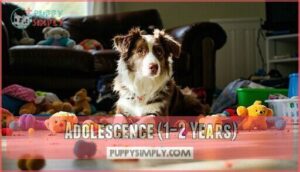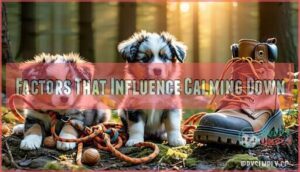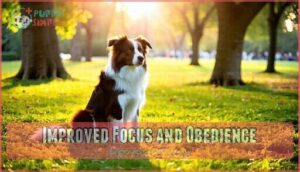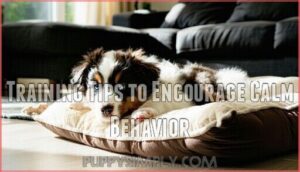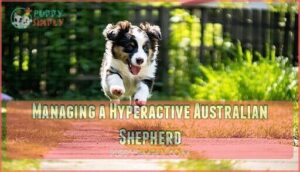This site is supported by our readers. We may earn a commission, at no cost to you, if you purchase through links.
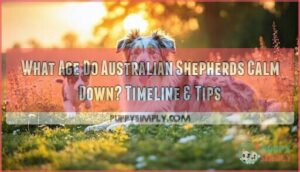
Individual dogs vary – some maintain their puppy enthusiasm until year three, while others mellow earlier depending on genetics, training consistency, and daily exercise routine. The shift happens gradually as their brain finishes developing and impulse control improves through structured activities and mental stimulation.
Understanding the specific developmental milestones and proven calming techniques can help you navigate this journey more effectively.
Table Of Contents
- Key Takeaways
- What Age Do Australian Shepherds Calm Down?
- Key Developmental Stages in Australian Shepherds
- Why Are Australian Shepherds So Energetic?
- Factors That Influence Calming Down
- Signs Your Aussie is Calming Down
- Exercise Needs for Mini and Standard Aussies
- Training Tips to Encourage Calm Behavior
- Managing a Hyperactive Australian Shepherd
- Health Considerations as Aussies Age
- Keeping Senior Aussies Happy and Engaged
- Frequently Asked Questions (FAQs)
- Conclusion
Key Takeaways
- You’ll typically see your Australian Shepherd start calming down between ages 2-4, with most settling into a more manageable energy level by their third birthday.
- Your Aussie’s genetics and herding instincts mean they’re hardwired for high energy, so you can’t completely train away their natural drive – only channel it productively.
- You can accelerate the calming process through consistent daily exercise (1-2 hours), mental stimulation, structured training, and establishing predictable routines.
- You’ll know they’re maturing when they show improved focus during training, less frantic hyperactivity, and an increased ability to settle and relax at home.
What Age Do Australian Shepherds Calm Down?
You’ll usually see your Australian Shepherd start calming down between 3 to 5 years of age, though this timeline varies greatly between individual dogs.
Some Aussies maintain their high energy levels throughout their lives, while others may show gradual behavioral maturation as early as 2 years or as late as 6 years old.
Typical Calming Timeline for Aussies
Getting ready for your Aussie’s development? Here’s what to expect. Most dogs start settling down between ages 2-3, once that wild puppy energy begins to fade. You’ll still see bursts of excitement during the teenage months, but real maturity typically kicks in around age 3.
Training and lifestyle choices can speed this up, though every dog’s different. Physical and mental exercise remain crucial for helping your dog find their calm.
Variability Among Individual Dogs
While general timelines exist, your Aussie’s path to calmness varies considerably. Individual energy levels and temperament differences mean some dogs mature faster than others.
Training impact, environmental factors, and owner influence all shape dog behavior patterns.
Your dog’s breed characteristics interact with their unique personality, creating a timeline specific to them for achieving that coveted calm canine temperament.
Key Developmental Stages in Australian Shepherds
Australian Shepherds go through distinct life stages that shape when they finally calm down. These four phases—puppyhood, adolescence, adulthood, and senior years—each bring different energy levels and behaviors.
Knowing what to expect helps you adapt your training methods as your dog matures.
Puppyhood (Birth to 1 Year)
Puppyhood brings a whirlwind of energy and boundless curiosity. Your Aussie puppy won’t calm down much during this stage, but you’re laying the groundwork for future behavior:
- Early Socialization – Expose them to different people, sounds, and experiences
- Basic Obedience – Start simple commands like "sit" and "stay"
- Potty Training – Establish consistent bathroom routines
- Crate Training – Create a safe, comfortable space
- Puppy Nutrition – Feed age-appropriate food for proper development
Energy levels remain sky-high throughout puppyhood.
Adolescence (1–2 Years)
Your once-adorable puppy now resembles a furry teenager with attitude. Adolescence brings teenage rebellion, training regression, and socialization challenges as independence emerges. Energy levels spike dramatically, making hyperactivity management tougher. This phase tests your patience but shapes your dog’s character.
| Behavior Challenge | What You’ll See | Your Response |
|---|---|---|
| Training Regression | "Forgetting" basic commands | Stay consistent, don’t give up |
| Teenage Rebellion | Testing boundaries daily | Maintain firm, fair rules |
| Socialization Issues | Sudden shyness or overexcitement | Continue positive exposure |
Adulthood (3–6 Years)
The sweet spot arrives! Your Australian Shepherd reaches peak physicality and mental sharpness during adulthood. These years bring balanced energy levels as adults settle into their personalities.
Your family bonds grow stronger during this stage, building deeper connections throughout your household.
Australian Shepherd behavior becomes more predictable, though you’ll still want to keep up with training. Their dog behavior shows better focus and sharper decision-making as they hit this prime stage.
Senior Years (7+ Years)
Your senior Australian Shepherd (7+ years) enters a calmer phase with reduced energy levels. Senior Aussie Care becomes paramount as aging Australian Shepherds face Arthritis Management challenges and potential Cognitive Decline.
Senior dog health requires monitoring Dietary Needs while maintaining Gentle Exercise routines. These senior dogs still need mental stimulation but at a gentler pace than their younger counterparts.
Why Are Australian Shepherds So Energetic?
You’ll understand your Aussie’s boundless energy when you learn they’re hardwired as working dogs with centuries of herding genetics in their DNA.
These intelligent problem-solvers were bred to think independently and stay alert all day, making decisions while managing livestock across vast ranch territories.
Breed Origins and Working Instincts
Your Aussie’s endless energy makes perfect sense when you consider where they came from.
These dogs were bred for grueling ranch work, which hardwired certain behaviors into their DNA that still drive them today.
Their Aussie purpose includes:
- Managing livestock across vast territories
- Making independent decisions quickly
- Working long hours without fatigue
- Responding to environmental challenges
These herding dog instincts explain why your Australian Shepherd seems unstoppable.
Herding Dog Mentality
Your Aussie’s herding instincts constantly drive their high energy levels and hyperactivity. These cattle dog descendants possess strong prey drive and pack mentality, making them natural problem-solvers who view everything as something to manage or control.
Their minds never truly "switch off" because herding requires constant vigilance. Effective dog energy levels management means understanding that Australian Shepherds aren’t just being difficult—they’re hardwired for action.
Factors That Influence Calming Down
Your Aussie’s path to calmness isn’t just about waiting for a magic birthday. Several key factors shape when and how your dog settles down.
Your dog’s genetics, training history, and daily routine all play into their behavioral timeline. These factors help you work with what comes naturally instead of fighting against it.
Genetics and Temperament
Genetics play a powerful role in your Australian Shepherd’s energy levels and temperament traits. Genetic predisposition determines breed characteristics like herding instincts and high drive.
Heritability factors influence behavioral genetics, meaning some Aussies inherit calmer temperaments while others maintain intense energy throughout life.
Your dog’s breed standards include natural alertness and work ethic that can’t be trained away completely.
Socialization and Training
Your dog’s socialization experiences and training consistency directly impact when they’ll calm down. Early socialization helps prevent anxiety-driven hyperactivity, while positive reinforcement builds confidence.
Dogs with extensive obedience training usually settle faster than untrained ones. Addressing anxiety through proper dog socialization and consistent obedience training creates the foundation for a calmer, more focused companion.
Routine and Environment
Your Aussie’s energy levels really come down to one thing: routine. Dogs are creatures of habit, and when they know what to expect each day, everything just clicks better. Picture how you feel when your morning goes smoothly versus when it’s chaotic—same principle applies here.
Safe spaces for dog rest, combined with environmental enrichment activities, help create a calming environment. When you reduce stressors through structured dog training and routine, you’re setting the stage for better behavior management.
Signs Your Aussie is Calming Down
You’ll notice your Aussie’s maturing when they start settling into a calmer rhythm around 3 to 5 years old.
Look for signs like less frantic energy, better focus during training sessions, and an increased ability to relax at home without constantly seeking stimulation.
Reduced Hyperactive Behaviors
Watch for subtle shifts in your Aussie’s behavior patterns. Hyperactivity generally decreases as they exit the puppy phase and adolescent years.
You’ll notice fewer frantic zoomies around the house and less destructive behavior from managing boredom.
Energy levels become more predictable with consistent training and early socialization providing better energy outlets through mental stimulation.
Improved Focus and Obedience
You’ll notice your maturing Aussie responds better to higher-level commands and shows impressive impulse control training progress. Training consistency pays off as they master distraction management skills that once seemed impossible.
Their breed-specific training needs become clearer, with obedience training sessions yielding faster results. Mental stimulation activities hold their attention longer, while exercise routines become more structured and purposeful.
Easier Relaxation at Home
Around your home, you’ll notice your Aussie choosing comfortable spaces for longer rest periods instead of constant pacing. Calming scents and relaxing music can improve these moments of canine calmness.
Your dog settles easier after the hyperactivity of adolescent years, finding cozy spots without needing constant entertainment or routine adjustments to manage energy levels.
Exercise Needs for Mini and Standard Aussies
You’ll need to match your Aussie’s exercise routine to their size, but don’t assume mini Aussies need less activity than their standard-sized cousins.
Both varieties require 1-2 hours of daily physical exercise plus mental challenges, though minis might tire slightly faster during intense activities like agility training.
Daily Physical Activities
Beyond basic walks, your Aussie needs Exercise Variety to tackle their sky-high energy levels. Mix running, hiking, and frisbee sessions with Agility Training to match their activity intensity requirements.
Standard Aussies need 90+ minutes daily, while Mini Aussies require 60-75 minutes of physical exercise. Outdoor adventures like trail runs become your secret weapon against hyperactivity, keeping those dog exercise needs satisfied through varied playtime duration.
Mental Stimulation Requirements
Physical exercise alone won’t tire your Aussie’s sharp mind. Mental stimulation through puzzle toys, training games, and scent work prevents destructive behaviors during the puppy phase and adolescent years. Rotate boredom busters like treat-dispensing balls and interactive toys to maintain engagement.
Social interaction with other dogs fosters cognitive challenges that nurture healthy canine development and balanced energy levels. Consider incorporating problem-solving exercises to further challenge their minds.
Training Tips to Encourage Calm Behavior
You can teach your high-energy Aussie to settle down through structured training that focuses on consistent, short sessions and positive reinforcement techniques.
The key is working with your dog’s natural intelligence while redirecting their boundless energy into calm, focused behaviors that become second nature over time.
Short, Consistent Sessions
Keep training sessions short—10 to 15 minutes max. Your Aussie’s attention span during those teenage months is pretty limited, so session length really matters here.
Frequency beats duration every time. A few quick sessions throughout the day work way better than one long training marathon. It’s easier to keep them focused when you wrap up while they’re still interested.
The real secret to training success? Show up consistently, not perfectly. You don’t need to cram everything into one exhausting session.
Positive Reinforcement Methods
Your training approach matters more than you’d think during the puppy phase and adolescent years. Positive reinforcement works like magic with Aussies – they’re naturally treat motivated and respond well to clicker training. Reward timing is everything in canine development, so mark good behavior instantly. Shaping behavior takes patience, but consistency matters most.
- Use high-value treats during peak excitement moments
- Click the exact second your Aussie shows calm behavior
- Reward settled stances like "down" or "place" commands
- Practice capturing calm moments throughout the day
- Keep treats ready during typical hyperactive triggers
Addressing Hyperactive Behaviors
Hyperactivity during the puppy phase requires strategic behavioral redirection and impulse control training. Use crate training to establish boundaries while teaching leash manners through consistent practice.
Implement socialization strategies early—teenage years are key for managing energy levels. When puppies calm down depends on consistent redirection techniques that channel their natural drive into appropriate outlets.
Managing a Hyperactive Australian Shepherd
If you’re dealing with a hyperactive Aussie that seems to bounce off walls like a furry pinball, you’re not alone in this energetic adventure.
Managing your dog’s excess energy requires consistent structure, proven calming techniques, and careful attention to avoid accidentally rewarding the very behaviors you want to reduce.
Establishing a Structured Routine
Building a solid routine transforms your Aussie from a whirlwind puppy into a well-adjusted adult. Think regular meal times, daily walks at the same hour, and play sessions your dog can count on. This predictability becomes the backbone of successful training.
- Morning routine: Feed at the same time, then head out for that essential walk
- Midday structure: Playtime doubles as perfect training opportunities
- Evening wind-down: Final exercise, then settle into a consistent bedtime
Here’s the thing—routine and training feed off each other. A structured day naturally calms an anxious or hyperactive dog.
Calming Techniques and Tools
Once you’ve got routines down, several calming aids can help your hyperactive Aussie find their zen. Anxiety wraps provide gentle pressure that soothes nervous energy, while calming music creates a peaceful atmosphere. Essential oils like lavender (used safely) and massage therapy work wonders for wound-up pups.
| Physical Tools | Environmental | Training Methods |
|---|---|---|
| Anxiety wraps | Calming music | Impulse control training |
| Massage therapy | Essential oils | Mental stimulation games |
| Weighted blankets | Dimmed lighting | "Settle" command practice |
These dog calming techniques target different triggers. Create a calming environment by combining multiple approaches—your Aussie will thank you for it.
Avoiding Reinforcement of Overactivity
Bouncing around like a pinball during puppyhood and adolescence, your Aussie craves attention—even negative reactions. Ignore excitement and hyperactivity completely.
Avoid attention when energy levels spike. Instead, redirect energy toward calm rewards like puzzle toys. Manage triggers by removing stimulating elements. Only reward settled behavior to shape better habits.
Health Considerations as Aussies Age
As your Aussie enters their senior years around age seven, you’ll notice their energy naturally decreases, but new health challenges emerge that require your attention.
Regular vet checkups become even more critical since arthritis, heart conditions, and other age-related issues can sneak up quietly and affect their comfort and mobility.
Common Senior Health Issues
Once your Australian Shepherd hits around seven years old, you’ll start seeing how age changes things.
These senior years bring health challenges that weren’t there before, making thoughtful care more important than ever:
- Arthritis Management – Joint stiffness and pain that affects mobility and comfort
- Heart Disease – Reduced stamina and breathing difficulties from cardiac conditions
- Cognitive Decline – Memory changes and confusion similar to dementia in humans
Weight Control and Dental Health also become priorities during this stage.
Dietary Adjustments for Older Dogs
During your senior dog’s aging process, you’ll need to adjust their diet to match their changing Senior Nutrient Needs. Reduce calories by 12-13% while increasing protein intake by up to 50% .
Consider Joint Supplementation with glucosamine for arthritis prevention. Higher-fiber foods improve gastrointestinal health, while Weight Management prevents obesity-related issues.
Hydration Importance increases with age, so ensure fresh water availability. Antioxidant-rich foods combat aging effects. Monitor their Dental Health closely during old age transitions.
Regular Veterinary Care
Beyond proper nutrition, your senior dog needs regular vet checkups to catch health issues early. Annual checkups become twice-yearly visits after age seven. Your vet will monitor for signs of aging like joint stiffness and cognitive changes.
- Watch for limping or reluctance to jump – early arthritis detection saves your buddy from unnecessary pain
- Notice changes in eating habits – dental health problems can make mealtime miserable
- Track bathroom accidents – kidney issues often start subtly in senior dogs
- Monitor breathing patterns – heart problems can sneak up on aging Aussies
- Keep up with vaccinations and parasite control – older immune systems need extra protection
Keeping Senior Aussies Happy and Engaged
Your senior Aussie’s golden years don’t mean the end of fun, just a shift to gentler activities that match their changing needs.
You’ll need to balance mental enrichment with physical comfort, keeping that sharp mind sharp while protecting aging joints from strain.
Gentle Exercise and Play
Your older Aussie doesn’t need to retire from fun—just shift gears. Low-impact activities like gentle walks and swimming provide physical exercise without stressing arthritic joints.
Senior Aussie games include slow-paced fetch and tug-of-war sessions. Mini Aussies especially benefit from mindful movement through short play bursts.
Replace high-intensity physical activity with arthritis-friendly play that keeps them moving comfortably.
Mental Enrichment for Older Dogs
Mental engagement becomes your senior dog’s lifeline as physical activity naturally decreases. Senior Dog Puzzles and Interactive Treat Toys help combat Cognitive Decline Signs by keeping aging minds sharp. Watch for canine cognitive dysfunction symptoms like disorientation or confusion. These Gentle Brain Games provide mental stimulation without physical strain.
- Use puzzle toys that dispense treats slowly to encourage problem-solving
- Try aromatherapy benefits with lavender or chamomile scents during quiet activities
- Rotate interactive toys weekly to maintain novelty and interest
- Practice simple obedience commands during calm moments for cognitive maintenance
Making The Home Senior-Friendly
When arthritis and lower energy start slowing down your senior dog, your house becomes part of the solution. Small ramps or steps by the couch mean they won’t have to struggle with those big jumps anymore. Swap out those slippery hardwood areas for something with grip—your pup’s wobbly legs will thank you.
An orthopedic bed makes a real difference for aching joints. Set food bowls at a height that doesn’t strain their neck, and toss some night lights in the hallways so late-night bathroom trips aren’t a navigation challenge. These tweaks keep your Aussie moving around confidently as they age.
Frequently Asked Questions (FAQs)
Do male or female Aussies calm faster?
Like watching paint dry, waiting for gender differences in calming—there aren’t any! Female Aussies are slightly calmer than males, but both usually mellow around 2-3 years.
Training and individual temperament matter far more than sex.
Can spaying/neutering affect energy levels in Aussies?
Spaying and neutering can slightly reduce energy levels in Aussies by removing hormone-driven behaviors. Most dogs return to normal energy levels after surgery, though you might notice improved focus and trainability once the initial recovery passes.
What supplements help hyperactive Australian Shepherds?
You’ll find relief with chamomile, valerian root, and passionflower supplements that naturally reduce hyperactivity.
Always consult your veterinarian for proper dosage before starting any supplement routine for your Aussie’s boundless energy.
Do Aussie mixes inherit the same energy?
Statistics show 80% of Aussie mixes inherit high energy levels regardless of their other parent breed.
Your mixed Aussie will likely share that same boundless enthusiasm and need for daily exercise that keeps purebred owners on their toes.
How does weather affect Australian Shepherd behavior?
Weather impacts your Aussie’s mood and behavior a lot. Cold weather makes them shivery and reluctant to go outside, while heat causes fatigue and restlessness. They’ll seem more anxious during storms.
Conclusion
Patience becomes your greatest ally when wondering what age Australian Shepherds naturally calm down. Most Aussies begin mellowing between 2-4 years, though individual genetics and training consistency heavily influence this timeline.
Remember that their high energy stems from centuries of herding work – it’s hardwired into their DNA. Consistent exercise routines, mental stimulation, and positive reinforcement training accelerate the calming process.
Your Aussie’s boundless energy comes from centuries of herding genetics—consistent training channels this drive productively
While you’re waiting for that magical transformation, embrace their enthusiasm and channel it productively through structured activities.
- https://a-z-animals.com/animals/australian-shepherd/australian-shepherd-facts/australian-shepherd-progression/
- https://www.pawlicy.com/blog/australian-shepherd-growth-weight-chart/
- https://www.reddit.com/r/AustralianShepherd/comments/14scg9r/when_do_aussie_puppies_get_better/
- https://www.oraussies.com/developmental-stages
- https://www.southtexasaussierescue.org/raising-an-australian-shepherd-temperament-and-development/


